 |
||
When working with quadratics one of the concepts you will definitely need to learn is something called 'completing the square.' Now those of you who have been in my classes are more than familiar with square numbers because we worked a LOT on memorizing the square roots and squares of numbers, right? NOW, all that work is going to pay off big time! The idea of 'completing the square' is useful because it helps when you want to re-write a quadratic equation into a form that allows you to apply the square root principle. It is another method that is kind of like factoring but utilizes squares. |
||
Here's a problem: |
||||
Step 1: Re-write your problem in the form ax2 + bx = c
|
||||
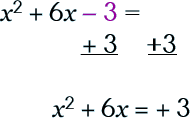 |
||||
Step 2: Take half of b. Now, square it.
|
||||||||||||||||||||
|
|
||||||||||||||||||||
|
|
||||||||||||||||||||
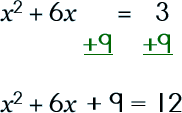 |
||||
Step 3: Add this number to each side of the equation.
|
||||
Step 4: Write the ax2 +bx +c side as a square.
|
||||
 |
||||
Step 5: Take the square root of each side.
|
||||||||||||
 |
||||||||||||
remember: |
||||||||||||
To see how the process is done in a linear, straight-forward way, here are two more examples. See if you can follow along… |
||
 |
|||||||||||||||
 |
|||||||||||||||
 |
|||||||||||||||
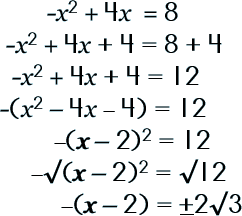 |
|||||||||||||||
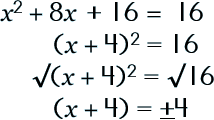 |
|||||||||||||||
 |
 |
||||||||||||||
Now, when you have a quadratic equation and a is NOT 1, this is when you will want to use some other steps to complete the square. Follow along, please. |
||
Here is a problem: |
||||
Step 1: Check to see if you can factor out a common factor.
|
||||
 |
||||
Step 2: Ignore the coefficient on the outside of the parenthesis. Re-write your problem in the form ax2 + bx = c
|
||||||
 |
||||||
Step 3: Take half of b. Now, square it.
|
|||||
Step 4: Add this number to each side of the equation.
|
||||
 |
||||
Step 5: Write the ax2 +bx +c side as a square.
|
||||
 |
||||
Step 6: Take the square root of each side.
|
||||||||
 |
||||||||
 |
 |
|||||||
What is a conjugate pair? Why, sometimes you may need to rationalize a number and so you will want to learn just how to do this. Conjugate pairs will help you do this. The reason you may want to rationalize a number is like when you have a radical in the denominator…eeewww! Nasty, right? So, to get rid of that nasty ol' radical, use the conjugate pair! Let's see what a conjugate pair LOOKS like. |
||
|
||||||||||||||||||||
So, why care about learning about conjugate pairs and what do they have to do with completing the square? Let's put some numbers in to substitute for the variables to see what happens and then multiply! |
||
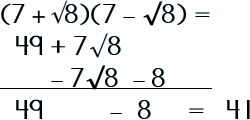 |
||||
Did you see what happened? It's the difference of two squares! The radicals disappeared! Yep, and all that was left…rational numbers! WOW… totally cool! |
||||
A conjugate pair is a binomial factor together which together with its original forms a product that is the difference of two squares. Wooo, what a mouthful. Basically, they are the sum and difference of the same two terms. (Either way, a mouthful!). Where can this be used? Why, you can use it to remove radicals from the denominator (I mean, really, who wants to deal with radicals in the denominator, for heaven's sake?). Let's try it. Say, you have a problem like the following and you are asked to rationalize the denominator. How would you do that? |
||
 |
||
Step 1: Multiply by the conjugate pair.
|
||||||||
 |
||||||||
 |
||||||||
Step 2: Simplify.
|
||||||||
 |
 |
|||||||
©2011–2017 Sherry Skipper Spurgeon. All Rights Reserved. |
||